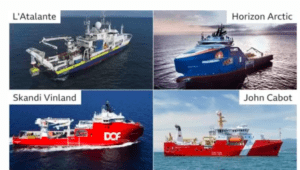Trending Stories
The Titan Submarine Tragedy: A Daring Journey Ends in Despair

The Titan Submarine Tragedy: A Daring Journey Ends in Despair
The Final Voyage of Titanic’s Deep-Sea Explorers
In an unsettling turn of events, the Titan, a tourist submarine voyaging in the vicinity of the sunken Titanic ship, has reportedly disappeared in the Atlantic Ocean.
As confirmed by OceanGate, the operator of the submersible, and the Coast Guard, the five individuals onboard have tragically lost their lives.
A Devoted Crew’s Last Chapter
The Titan’s ill-fated explorers were OceanGate’s CEO, Stockton Rush, Shahzada Dawood with his son, Suleman Dawood, Hamish Harding, and Paul-Henri Nargeolet.
Described as “true explorers with a distinct spirit of adventure,” these men held a profound passion for the exploration and conservation of the world’s oceans. As we grieve their loss, we also celebrate the joy and passion they brought to the lives they touched.
A Search Marked by Debris
In a recent update, the US Coast Guard announced the discovery of a debris field in the area being searched for the ROV (Remotely Operated Vehicle) near the Titanic.
Some experts express concerns that the Titan may have suffered a catastrophic implosion due to a hull failure, which could potentially explain the debris. The seafloor around the Titanic wreckage is riddled with various debris, mainly from the historic ship itself.
Oxygen, Cold, and Hope
The exact condition of the Titan submarine and the five crew members remains unknown. Considering the limited oxygen supply, the urgency to locate the sub before it’s too late is paramount.
However, as explained by Dr. Ken LeDez, a hyperbaric medicine expert from Memorial University in St John, Newfoundland, the timeline isn’t rigid. Survival depends on various factors, including temperature and oxygen management.
The crew would have faced multiple threats, including decreasing oxygen levels, rising carbon dioxide levels with potentially fatal consequences, loss of electrical power, and hypothermia.
However, the human body’s ability to adapt under extreme conditions brings a glimmer of hope, suggesting some crew members might have survived longer than initially expected.
Additional Deep-Sea Search Equipment Mobilized

The search operation is a joint effort of US and Canadian agencies, navies, and commercial deep-sea firms, all coordinated from Boston, Massachusetts.
Various vessels with different capabilities, including commercial cable-laying ships, offshore supply vessels, subsea support vessels, scientific research vessels, and naval ships, have been deployed.
Timeline of the Titan’s Disappearance
The Titan was launched from the Polar Prince at 08:00 local time on Sunday. Contact was lost approximately one hour and 45 minutes into its descent, at about 09:45.
The Coast Guard was notified of the issue around 17:45, eight hours later, with search efforts starting shortly thereafter.
The Titan was equipped with a four-day emergency supply of oxygen, which, at the time of the announcement, was projected to last between 70 and 96 hours.
An Unforeseen End
As we mourn the loss of these brave explorers, we are reminded of the inherent risks in the quest to explore and understand our planet’s deepest secrets. Their legacy will continue to inspire future generations of ocean explorers and conservationists.
The tragic loss of the Titan’s crew highlights the inherent dangers of deep-sea exploration. Deep below the ocean’s surface, the environment is not only alien but also extremely hostile to humans.
The pressure can be crushing, temperatures are near freezing, and there’s no natural light. In such an environment, any malfunction or failure of equipment can lead to a catastrophe.
While the technology for deep-sea submarines has improved dramatically over the years, accidents like this underline the stark reality that the deep ocean is still a dangerous and unpredictable place.
In the event of an incident, the depth and the inhospitable conditions can make rescue operations incredibly challenging, if not impossible.
The Deep Ocean – Earth’s Final Frontier

Despite the risks, the desire to explore and understand the deep ocean continues to drive daring explorers like those aboard the Titan.
Covering over 60% of the Earth’s surface and reaching depths of up to 36,000 feet, the deep ocean is often called Earth’s final frontier. It’s a world full of mystery, beauty, and an astonishing array of life forms.
In many ways, the exploration of the deep ocean is similar to space exploration. Both involve venturing into hostile, alien environments using technology as our lifeline.
And in both cases, the spirit of exploration, the thirst for knowledge, and the drive to push human boundaries persist despite the risks.
The Legacy of the Titan’s Crew
While the loss of the Titan’s crew is deeply tragic, their spirit of adventure, courage, and dedication to ocean exploration will not be forgotten.
Their pursuit of knowledge and understanding of the deep sea is a reminder of our enduring curiosity and our willingness to venture into the unknown in the quest for discovery.
In the wake of this tragedy, it’s essential to not only remember and honor those who lost their lives but also to reflect on why they risked those lives in the first place.
The bravery and dedication of these ocean explorers underscore the importance of our oceans and the need for their ongoing exploration and conservation.
As we move forward, we carry the memory of these explorers and their noble mission with us. Their sacrifice will continue to inspire future generations of ocean explorers, driving us to develop safer methods of exploration, improve our understanding of our planet’s oceans, and conserve these vast, mysterious, and beautiful regions for generations to come.
Trending Stories
Can Supplements Fix Belly Fat? Experts Weigh in on the “Cortisol Pouch” Myth
Trending Stories
Sister Regina Liu: Empowering Health Through Acupuncture

Sister Regina Liu: Empowering Health Through Acupuncture
In the bustling world of healthcare, Sister Regina Liu stands out as a beacon of holistic healing. Her journey into the world of acupuncture is not only inspiring but also transformative for the countless individuals she has treated.
Through her dedication, Sister Regina has brought traditional Chinese medicine to the forefront, offering an alternative and complementary approach to modern medical practices.
The Journey of Sister Regina Liu
Sister Regina Liu’s path to becoming a renowned acupuncturist began with her deep-rooted interest in holistic health. Born into a family that valued traditional Chinese medicine, Sister Regina was exposed to the benefits of acupuncture from a young age. Her early fascination turned into a lifelong passion as she pursued formal education and training in the field.
Acupuncture: Bridging Ancient Wisdom and Modern Health
Acupuncture, a practice with origins in ancient China, involves inserting thin needles into specific points on the body to balance the flow of energy or “qi.” Sister Regina Liu has mastered this ancient art, using it to address a wide range of health issues.
From chronic pain to stress management, her expertise has provided relief to many who had exhausted conventional treatment options.
Impact on Community Health
Sister Regina’s impact extends beyond individual treatments. She has been instrumental in educating the community about the benefits of acupuncture, breaking down misconceptions, and making the practice more accessible.
Her workshops and seminars have enlightened many about the holistic approach to health, emphasizing the interconnectedness of body, mind, and spirit.
Success Stories and Testimonials
The success stories of Sister Regina’s patients are a testament to her skill and dedication. Many individuals who had lost hope found solace in her treatments.
For instance, Maria, a long-time sufferer of migraines, experienced significant relief after just a few sessions with Sister Regina. Her story is just one of many that highlight the transformative power of acupuncture under Sister Regina’s care.
Challenges and Triumphs
Like any journey, Sister Regina’s path was not without challenges. Integrating acupuncture into mainstream healthcare faced resistance initially.
However, her perseverance and the undeniable results of her treatments gradually won over skeptics. Today, Sister Regina is not only respected in the field of acupuncture but also in the broader medical community.
The Science Behind Acupuncture
While acupuncture is rooted in ancient practices, modern science has begun to unravel the mechanisms behind its effectiveness. Studies have shown that acupuncture can stimulate the release of endorphins, the body’s natural painkillers, and improve blood circulation.
These scientific validations have further cemented acupuncture’s place in contemporary healthcare, thanks in part to advocates like Sister Regina Liu.
Acupuncture in Modern Healthcare
Sister Regina’s work exemplifies how traditional practices can complement modern medicine. Hospitals and clinics increasingly incorporate acupuncture into their treatment plans, recognizing its benefits in pain management, mental health, and overall well-being. This integration signifies a broader acceptance and understanding of holistic health practices.
Future Vision
Looking ahead, Sister Regina Liu envisions a future where acupuncture and traditional Chinese medicine are fully integrated into the global healthcare system. She continues to advocate for research, education, and policy changes that support the inclusion of holistic practices in mainstream medicine.
How to Get Started with Acupuncture
For those new to acupuncture, Sister Regina offers practical advice on getting started. She recommends finding a certified acupuncturist, understanding the treatment process, and maintaining an open mind. Her guidance helps demystify acupuncture, making it more approachable for newcomers.
Conclusion
Sister Regina Liu’s journey in empowering health through acupuncture is a remarkable tale of dedication, resilience, and success. Her contributions have not only alleviated individual suffering but also enriched the broader understanding of holistic health. As acupuncture continues to gain recognition, Sister Regina’s legacy will undoubtedly inspire future generations of healers.
FAQs
1. What conditions can acupuncture treat?
Acupuncture can address various conditions, including chronic pain, migraines, stress, anxiety, digestive issues, and more. It is also used to support overall wellness and balance.
2. Is acupuncture safe?
Yes, when performed by a certified and experienced acupuncturist, acupuncture is safe. It involves using sterile, single-use needles and adhering to proper hygiene practices.
3. How many sessions are needed to see results?
The number of sessions varies depending on the condition and individual response. Some may experience relief after one session, while others may need multiple treatments.
4. Does acupuncture hurt?
Acupuncture needles are very thin, and most people feel minimal to no discomfort. Some may feel a slight tingling or warmth at the needle site.
5. How do I find a qualified acupuncturist?
Look for acupuncturists who are certified by recognized professional organizations and have positive patient reviews. Personal recommendations and consultations can also help in making an informed choice.
References
Trending Stories
In 2 Shape Gym Unveils Major Expansion in Stourport
-

 Trending Stories1 year ago
Trending Stories1 year agoCDC: 1 in 4 Americans Still COVID-Free by End of 2022
-

 Health5 years ago
Health5 years agoMeghan Trainor Shares Motivational New Song ‘Blink’
-

 Health6 months ago
Health6 months agoHow Do Pawpaw Seeds Support Cardiovascular Health?
-

 Health2 years ago
Health2 years agoHow Long Does Monkey Pox Last Before It Surfaces in the Body?
-

 Health3 years ago
Health3 years agoWhat Causes Swollen Body? Understanding Edema and its Triggers
-

 Health3 years ago
Health3 years agoNutrition and the Importance of a Fitness Program – 3 Things to Know
-

 Health3 years ago
Health3 years ago5 Weird Reasons Why Pimples Disappear After Marriage
-

 Health2 years ago
Health2 years agoHealth Benefits Of Pawpaw Seed? 7 Things To Know







